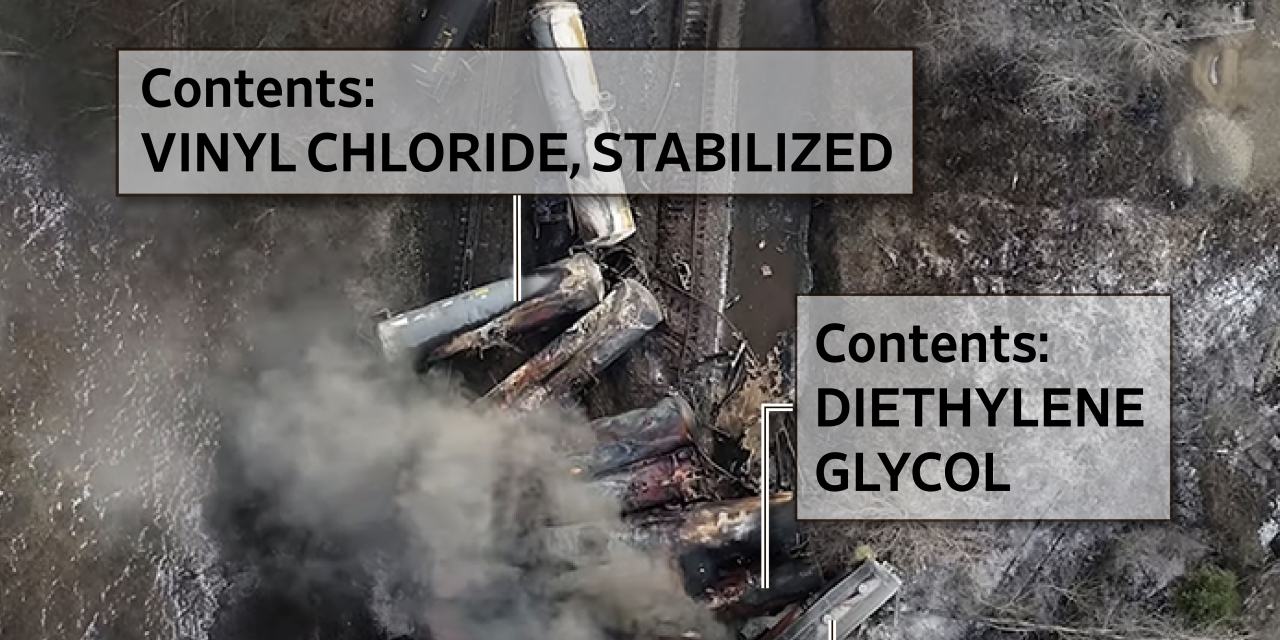Months-Long Persistence Of Toxic Chemicals From Ohio Derailment

Table of Contents
The Toxic Cocktail Released in East Palestine
The February 3rd derailment unleashed a torrent of hazardous materials, including vinyl chloride, butyl acrylate, ethylhexyl acrylate, and ethylene glycol monobutyl ether. These chemicals pose immediate and long-term health risks due to their volatility and toxicity.
-
Specific Chemicals and Health Effects:
- Vinyl Chloride: A known carcinogen linked to liver cancer, brain cancer, and other serious health problems. Highly volatile, it can easily evaporate into the air.
- Butyl Acrylate: An irritant to the skin, eyes, and respiratory system. It can also cause allergic reactions. Persists in soil and water.
- Ethylhexyl Acrylate: Similar to butyl acrylate in its irritant properties and potential for environmental persistence.
- Ethylene Glycol Monobutyl Ether: Toxic if inhaled or ingested, impacting the nervous system and causing kidney and liver damage. It can contaminate groundwater.
-
Volatility and Persistence: The initial response involved a controlled burn of vinyl chloride to prevent a potential explosion, releasing toxic fumes into the air. However, other chemicals, like butyl acrylate, persist in the soil and water, posing a longer-term threat. The precise environmental half-lives of these chemicals in the specific East Palestine context are still being investigated, making long-term risk assessment particularly challenging.
-
Initial Response and Cleanup Efforts: The initial cleanup involved evacuations, air and water monitoring, and attempts to contain the spread of contamination. However, concerns remain about the thoroughness and effectiveness of these initial efforts, and the long-term monitoring and cleanup strategy.
Persistent Contamination of Soil and Water
Months after the derailment, concerns persist regarding the ongoing contamination of soil and water sources in and around East Palestine. The extent of the contamination is still being fully assessed, but early findings paint a concerning picture.
-
Extent of Contamination: Testing has revealed elevated levels of contaminants in soil and water samples, though the full geographic extent of the pollution remains uncertain. Ongoing testing and sampling are crucial to fully map the impacted area.
-
Assessment Methods: A variety of methods are being used to assess the extent of contamination, including soil sampling, water testing from wells and surface water sources, and air quality monitoring. The data obtained are critical for guiding remediation efforts.
-
Remediation Challenges: Cleaning up contaminated soil and water is a complex and lengthy process. The specific properties of each chemical, along with the heterogeneous nature of the affected environment (soil types, water sources), present significant challenges. Effective remediation requires a multifaceted approach tailored to each contaminant.
-
Leaching and Groundwater Contamination: A major concern is the potential for leaching of chemicals from contaminated soil into groundwater sources. This could lead to long-term contamination of drinking water supplies and pose a significant threat to human health and the local ecosystem.
Long-Term Health Effects on the Community
The exposure to this toxic cocktail raises significant concerns about the long-term health effects on residents of East Palestine and neighboring communities. The potential consequences are far-reaching.
-
Potential Health Issues: Residents face potential risks of respiratory problems (such as asthma and bronchitis), various cancers (due to exposure to carcinogens like vinyl chloride), liver and kidney damage, and other chronic health issues.
-
Ongoing Health Monitoring and Studies: Long-term health monitoring is crucial to track the health status of residents and establish a correlation between chemical exposure and potential health problems. Independent epidemiological studies are necessary to fully assess the long-term health impacts.
-
Available Resources: It is imperative that residents have access to comprehensive healthcare, including screenings, testing, and treatment for any health issues potentially linked to the derailment. The availability of support services and resources for those affected must be prioritized.
Environmental Impact and Ecosystem Recovery
The derailment's impact extends far beyond human health. The surrounding ecosystem has also suffered significant damage.
-
Effects on Flora and Fauna: The toxic chemicals can have devastating effects on local flora and fauna, potentially leading to reduced biodiversity, habitat loss, and disruption of food webs. The long-term effects on wildlife populations are yet to be fully understood.
-
Challenges in Assessing Ecological Consequences: Accurately assessing the long-term ecological consequences requires extensive research, monitoring, and analysis. The complex interplay between various pollutants and the environment makes this task challenging.
-
Bioaccumulation and Biomagnification: A critical concern is the potential for bioaccumulation (the buildup of toxins in organisms) and biomagnification (the increasing concentration of toxins at higher levels of the food chain). This can have severe implications for the health of the entire ecosystem.
The Slow Pace of Cleanup and Accountability
The cleanup process has faced criticism for its slow pace and perceived lack of transparency. Public concerns regarding accountability are also paramount.
-
Delays and Inadequacy of Initial Responses: The initial response to the derailment has been criticized for being slow and inadequate, raising concerns about potential environmental and public health consequences.
-
Transparency and Communication: Lack of clear communication and transparency surrounding the cleanup efforts have fueled public distrust and concerns about potential cover-ups.
-
Legal Actions and Investigations: Several lawsuits have been filed against the railroad company and other involved parties. Government investigations are also underway to determine the cause of the derailment and assess the adequacy of the response.
Conclusion
The Ohio train derailment's consequences extend far beyond the initial disaster. The months-long persistence of toxic chemicals poses a significant and ongoing threat to the health of the community and the environment. The slow pace of remediation and unanswered questions about long-term health impacts necessitate continued vigilance and thorough investigation.
We must demand greater accountability and transparency regarding the cleanup efforts and long-term monitoring of the environmental and health impacts of this devastating event. Staying informed about the ongoing effects of the Ohio derailment's toxic chemicals and advocating for comprehensive solutions is crucial for the protection of East Palestine and its residents. Continue to seek updated information from reputable sources and support organizations working to address this persistent environmental crisis.

Featured Posts
-
 Teslas Future How Elon Musks Temper Impacts The Company
May 27, 2025
Teslas Future How Elon Musks Temper Impacts The Company
May 27, 2025 -
 Kai Cenat Brings Streamer University To Akron University Students
May 27, 2025
Kai Cenat Brings Streamer University To Akron University Students
May 27, 2025 -
 Interesul Politic Si Schimbarea Parerilor O Perspectiva De La Mirel Curea
May 27, 2025
Interesul Politic Si Schimbarea Parerilor O Perspectiva De La Mirel Curea
May 27, 2025 -
 Yellowstone Spinoff John Dutton Iiis Continued Role Without Kevin Costner
May 27, 2025
Yellowstone Spinoff John Dutton Iiis Continued Role Without Kevin Costner
May 27, 2025 -
 Growth Of Alternative Delivery Services Amidst Canada Posts Difficulties
May 27, 2025
Growth Of Alternative Delivery Services Amidst Canada Posts Difficulties
May 27, 2025
Latest Posts
-
 Manitoba Snow Warning Significant Snow Accumulation Tuesday
May 30, 2025
Manitoba Snow Warning Significant Snow Accumulation Tuesday
May 30, 2025 -
 Western Manitoba Snowfall Warning Heavy Snow Expected Tuesday
May 30, 2025
Western Manitoba Snowfall Warning Heavy Snow Expected Tuesday
May 30, 2025 -
 Enhanced Emergency Care Advanced Paramedics Arrive In Rural And Northern Manitoba
May 30, 2025
Enhanced Emergency Care Advanced Paramedics Arrive In Rural And Northern Manitoba
May 30, 2025 -
 Parts Of Western Manitoba Under Snowfall Warning 10 20 Cm Expected Tuesday
May 30, 2025
Parts Of Western Manitoba Under Snowfall Warning 10 20 Cm Expected Tuesday
May 30, 2025 -
 Manitoba Invests In Advanced Care Paramedics For Rural And Northern Communities
May 30, 2025
Manitoba Invests In Advanced Care Paramedics For Rural And Northern Communities
May 30, 2025
